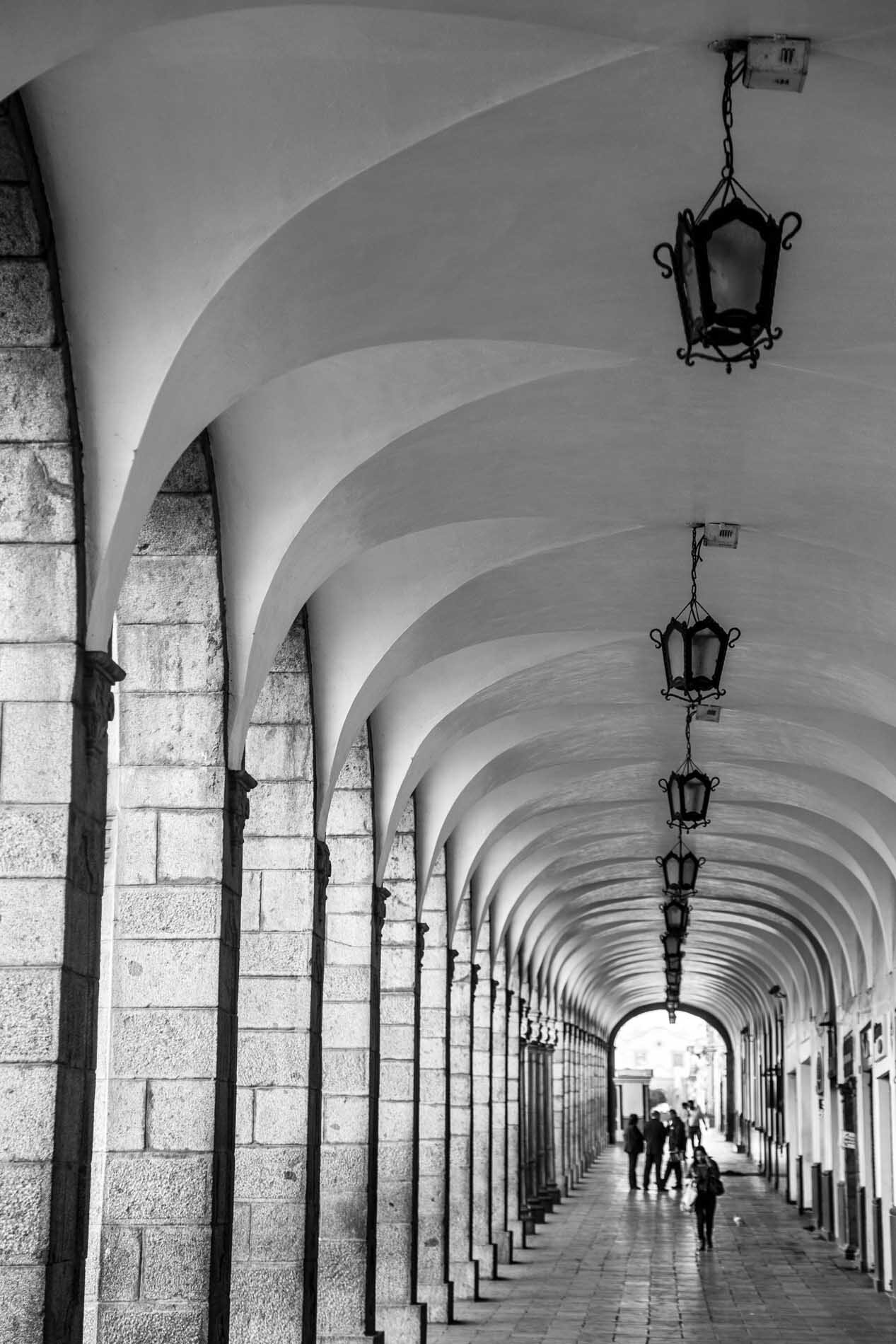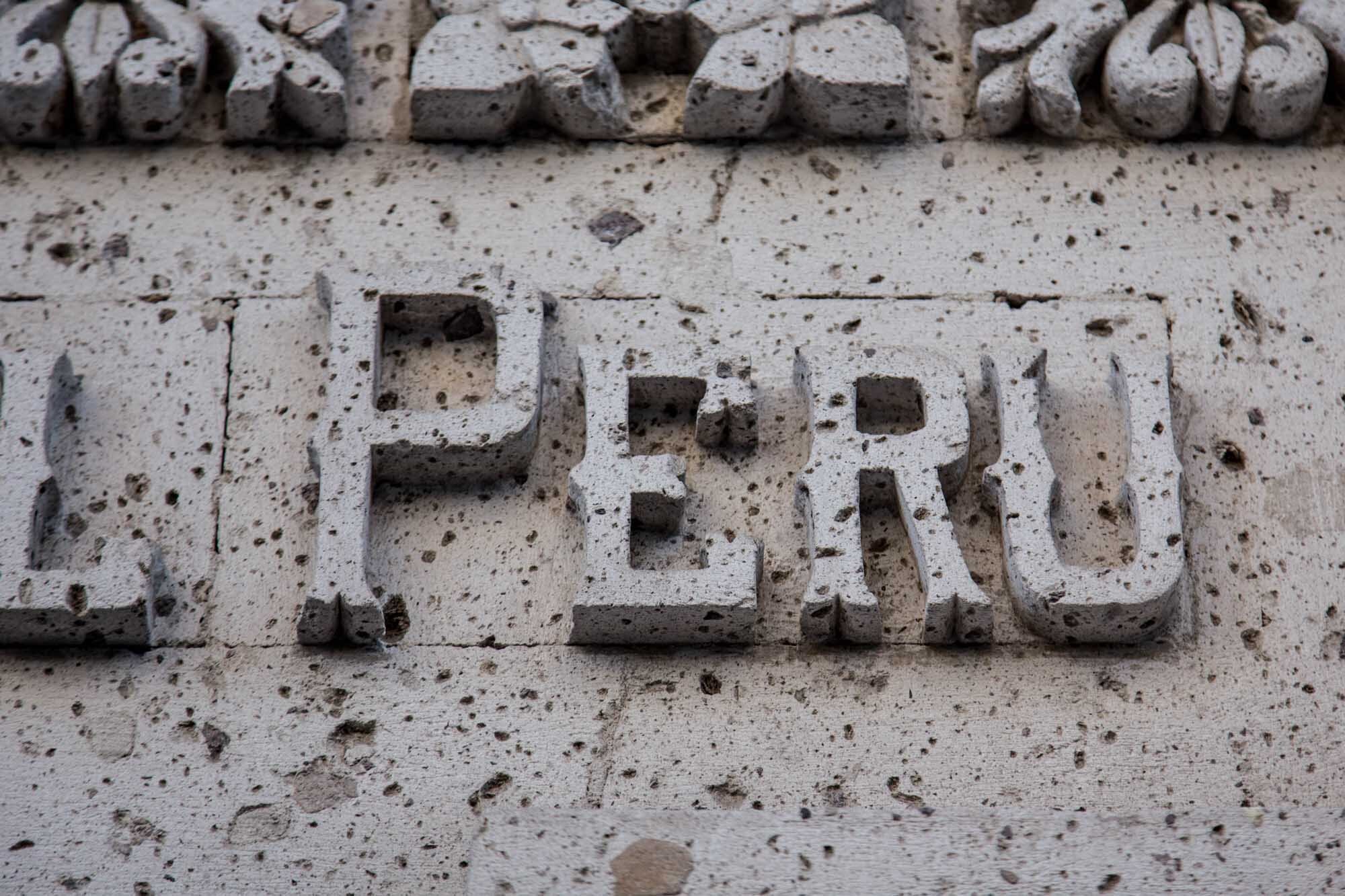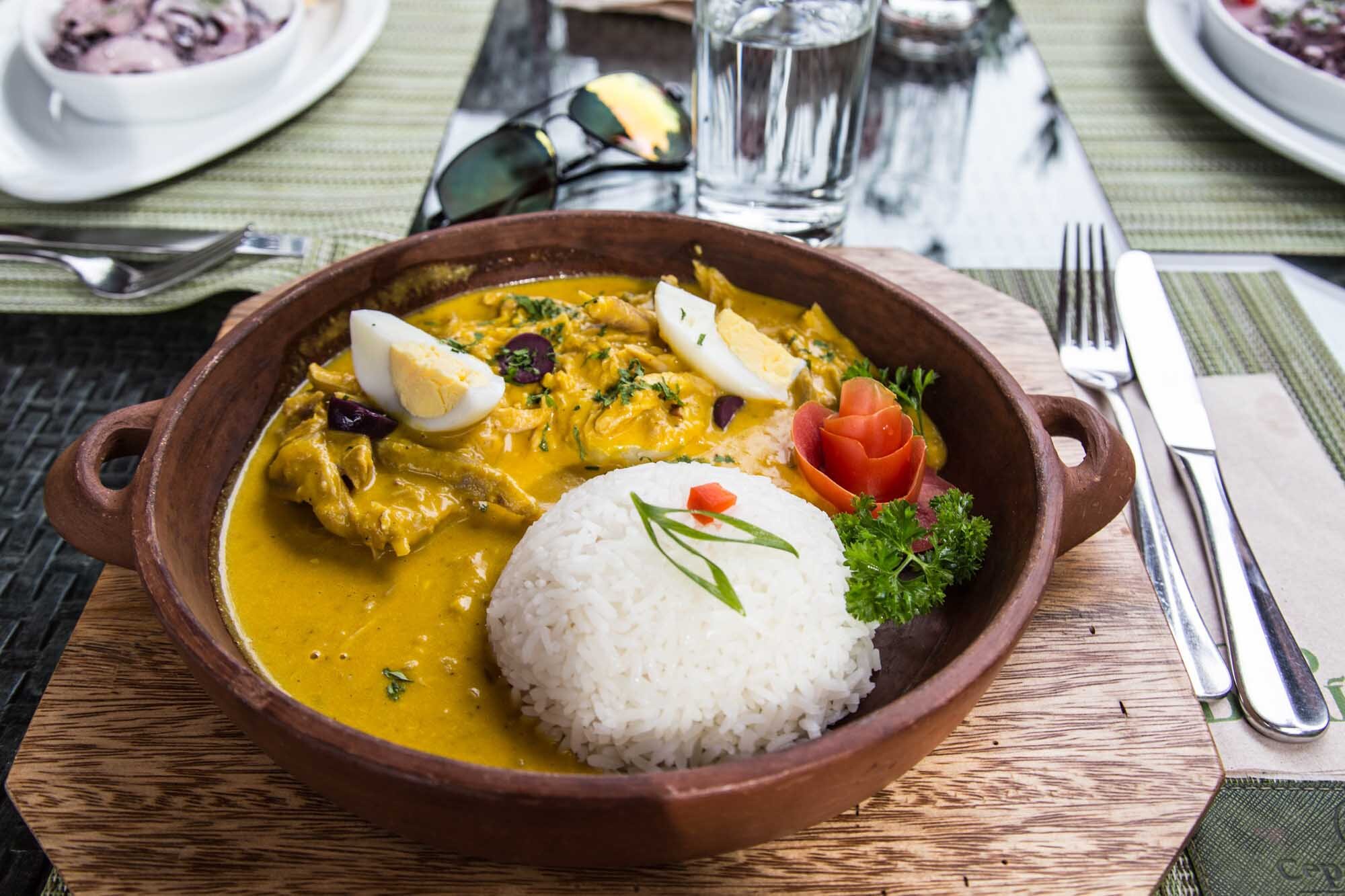
AREQUIPA
What to do in Arequipa in four days.
Authentic food, majestic volcanoes and stunning hikes.
Arequipa enchanted us with its colonial-era beauty and charm.
Nicknamed La Ciudad Blanca (“The White City”) for its unique white buildings made of sillar – pearly white volcanic rock – Arequipa is located in southwestern Peru at an altitude of 2,300 metres above sea level.
This is Peru’s second largest city after Lima and is a ferocious rival of the capital. There’s a strong sense of regionalism among the Arequipeños that roots deep in the city’s history and the relationship with the tentacular Lima.
Arequipa blinks an eye to Europe, rather than to other Inca-oriented Peruvian cities. The colonial architecture of the UNESCO protected city centre is there to admire, with its carved facades, colourful balconies, well-manicured plazas with vibrant flower beds and palm-trees.
The local cuisine is a real heaven for food-lovers. This city has more local dishes than any other city in Peru. Food markets and traditional picanterias are the protagonists of this vibrant food scene. Taking a cooking class is a great way to appreciate the incredible local food.
Arequipa’s skyline is dominated by three dramatic volcanoes, with the majestic snow-capped El Misti visible from every corner of the city.
The mountainous topography affects the low-pressure fronts and blesses the city with spring-like temperatures all year-round and an average of 300 days of sunshine yearly. No wonder that Arequipa is home to some of the friendliest Peruvians!
Tired of urban vibes? Say no more! Pack your best hiking shoes, Arequipa is the perfect base to explore the mighty Colca Canyon.
RECAP & ITINERARY
When? April. How long? 4 days. Temperature? Mostly sunny, around 22-23° C. Budget? 400-500€ per person all inclusive. Planning needed? Moderate. Accommodation? Casa Andina Select, right in the main square. What to book in advance? The trek of the Colca Canyon with the agency Trek the Colca.
***
Day 1 // Plaza de Armas / Monasteiro de Santa Catalina / Walk to Mirador Yanahuara
Day 2 // Colca Trek
Day 3 // Colca Trek
Day 4 // San Camilo Market / Cooking class / Mundo Alpaca / Night bus to Cusco
CONTENT
PLAZA DE ARMAS: THE CATHEDRAL & HISTORIC CENTRE
THE ANDEAN CUISINE: AREQUIPA’S FOOD SCENE
SAN CAMILO MARKET: THE HOME OF LOCAL GASTRONOMY
YANAHUARA: VIEW FROM THE MIRADOR
MUNDO ALPACA: TOUR & FURRY MEMORIES
COLCA CANYON: A STUNNING 2-DAY TREK






OUR HIGHLIGHTS
PLAZA DE ARMAS: THE CATHEDRAL & HISTORIC CENTRE
Plaza de Armas is one of the finest squares in Peru and the ideal starting point to explore Arequipa’s historic centre.
It’s an open-air museum dedicated to the sillar, the volcanic rock used for every building facing the square.
Plaza de Armas has a lively atmosphere and is crowded with tourists and locals at any moment of the day, especially in the evening when the Cathedral is illuminated with a romantic, warm light. If you want to take good photos in peace (see below) head there at dawn and enjoy the square almost for yourself.
At the centre of the square, surrounded by palm trees, there’s a fountain called Pileca with on top a bronze statue of a pixie (called Tuturutu) with a trumpet. It’s here that Arequipa was founded in 1540 by Garcí Manuel de Carbajal.
The neoclassical Basilica Cathedral of Arequipa is the main landmark in Arequipa.
Two adjectives fit the bill for the beloved Catedral: majestic and resilient.
Majestic, because of its beauty and size. It stretches the entire length of the square (the only one in Peru) and it’s skilfully made out white sillar.
Resilient, because it rose from its ashes many times throughout history. It was flattened by earthquakes (1583, 1604, 1886) and damaged by fire (1844) but the local community never failed to put it back together. The last earthquake in 2001 destroyed the left tower and damaged the right one – but in less than one year both towers were restored and are now in great shape.
The Cathedral houses some invaluable objects, including the allegedly largest organ of South America (15-metres high, donated by Belgium).
You can visit for free every day but Sunday, and you need to cover your shoulders and knees to enter.
There’s a museum with works of art too, but it’s only accessible with a bilingual guided tour for around 10€ pp.
There are many attractions around Plaza de Armas.
First, don’t miss the sublime facade and rich interior of the Iglesia de la Compañía, a Jesuit church right at the corner of the main square. This is a perfect example of the Andean Baroque, a local art style that is the result of a prolific collaboration of criollo and indigenous craftsmen and that finds its best expression in religious architecture.
Then check the pretty Casa Tristan del Pozo, two-minute walking north of the square, a regal colonial mansion (casona) converted into the art gallery. The gallery is free to enter and displays works from painters of the local Arequipeña school.
The Monasteiro de Santa Catalina de Siena is a monastery of Dominican nuns and one of the most photographed spots of the city. You can visit it with a 90-minute guided tour for around 10€ pp and then you are free to roam around the beautiful structure.
Another famous attraction is the Museo Santuario Andino that exhibits the well-preserved ice princess Juanita, a mummy found in a nearby volcano at 6,000 metres of altitude – there’s a compulsory tour, ticket is 9€ pp. From January to April another similar mummy is put on display for the visitors.
Finally, go for a stroll along the lively Calle Mercaderes – perfect for shopping – and get impressed by the bold style of the marble facade of the city theatre and the Banco Internacional del Perú.
EATING IN AREQUIPA: TIPS & RECOMMENDATIONS
The food scene in Arequipa is just brilliant.
We tried a few restaurants and some street food stalls and we can confirm that what you read online is all true. Arequipa is the food capital of Peru.
Peruvian vegetables, fruit and meat are extremely tasty. We are so used to packaged food in the UK that it felt so good to taste again the real rich flavour of peppers or tomatoes.
For a proper Peruvian experience, head to the family-run picanteria La Nueva Palomino near Yanahuara. A multitude of Arequipeños floods this restaurant for the lively vibe and the generous portions of traditional food.
This is the ideal place to fill your boots with hearty local dishes like rocoto relleno (spicy rocoto pepper stuffed with tender beef and spices, topped with melted cheese), chupa de camarones (shrimp chowder) and almendrado de pato (duck in almond sauce). Only for the braves, that’s your chance to try the cuy chactado - a guinea pig, pan fried under a flat and heavy stone.
It’s also worth trying two local-favourite drinks: the chicha de jora (fermented corn beer) and the non-alcoholic chicha morada.
We also followed the smell of grilled meat and we landed in Parrilla de Zingaro, a restaurant specialised in charcoal grilled meat, offering a fusion between Peruvian flavours and cuts from Argentina and Uruguay.
This is a sister restaurant of the upscale and innovative Zingaro (here), sharing with them a vast wine selection and a beautiful location in an old vaulted sillar building.
Some succulent treats for carnivores: order the skewered anticuchos (chunks of beef heart served with potatoes and corn, rich in flavour and with an interesting texture) and a juicy lomo saltado de alpaca (a traditional stir fry with marinated cubs of alpaca sirloin, served with tomatoes and onions). Roasted potatoes are a must as a side.
For dessert, get their delicious queso helado (cheese ice-cream), a refreshing and delicious dessert born in Arequipa. It doesn’t look or taste like cheese, but it shares the basic ingredient, milk, plus eggs, coconut and cinnamon.
For street food lovers, keep your eyes peeled for the vendors selling picarones (a kind of sweet, fried doughnut, made of squash and sweet potatoes and covered in syrup) or the sandwich with chicharrones (fried pork belly).
Other spots we researched but didn’t have enough time to try are Hatunpa (a tiny, budget-friendly restaurant specialised in potatoes), Zig Zag (a city-staple with some European influence, upscale but not too pricey and usually with long queues) and Arthur Restaurant (perfect for some experimentation and fantastic cooking classes like we did).
SAN CAMILO MARKET: THE HOME OF AREQUIPAN GASTRONOMY
San Camilo Market is the beating heart of the Arequipan gastronomy.
Full of life and exotic flavours totally alien to an European traveller, this bustling market spans an entire city block, just a 10-minute walk away from Plaza the Armas.
The San Camilo Market is divided into 32 well-organised sections with over 1,000 merchants – that’s why it’s the best place to get a glimpse of the diversity and variety of Peru.
The goods range from the biggest and weirdest vegetables, colorful exotic fruit, juices, local cheese, meat, fish, infinite varieties of grains, traditional medicine and artisan products.
Two absolute must-dos in San Camilo.
One: have lunch at the homey tables of Doña Vilma’s restaurant, Chichos, for some costillar frito (crispy fried cow ribs).
Two: follow your sweet tooth and get the incredible queso helado (cheese-flavoured ice cream) at Doña Rosa on the second floor.
You shouldn’t really miss the visit to San Camilo Market, even if it’s just for a quick stroll.
It’s the best way to get a glimpse on the culture, the folklore and the gastronomy of Arequipa in one single session.
We visited the market with Chef Arthur as part of our cooking class experience (read about it here), sampling delicious fresh fruit and chatting with the locals. You can visit the market on your own and without a guide, just have some money ready for tipping if you want to sample food from the stalls.
And then, potatoes.
Yes, you’ve read in your guide that there are more than 2,000 varieties of potatoes in Peru – but even if you come prepared, being surrounded by more than thirty different types of potatoes is quite impactful.
The most incredible are the Chuño, basically freeze-dried potatoes. Chuño are still being made the same way it has been by the Inca: the locals repeatedly freeze and thaw the potatoes before crushing them underfoot to remove all the liquids.
Potatoes can be stored for decades thanks to this process and then can be quickly cooked, a pretty convenient food if you live in the harsh Andes and have to travel long distances!
The building itself is an ode to the cast-iron architecture.
Once inside, the locals will totally tell you that the market was built by Gustave Eiffel, the French engineer who built the Eiffel Tower.
Unfortunately this is just local folklore, as the iconic corrugated metal roof and the supporting iron columns were built in the 20th century by a local company, way after Eiffel times (the New York Times wrote about it).
YANAHUARA: VIEW FROM THE MIRADOR
Yanahuara District is a pretty and tranquil middle-class residential neighbourhood, northwest to the city centre. It’s well known for the tall buildings built from sillar, charming cobble-stoned alleyways and colonial churches.
Getting there is a pleasant and slightly uphill 15-minute walk.
From the Monasterio de Santa Catalina, go west on Puente Grau and over the bridge, then take the first right along Francisco Bolognesi. Take the first left on Cuesta del Ángel and continue four blocks to Plaza Yanahuara.
Plaza Yanahuara is a small park dotted with bougainvilleas and palm trees.
It features a mirador, or viewpoint, offering stunning views across Arequipa and the volcanic peaks beyond it.
The main volcano, El Misti, towers in the distance with its white peak, framed by old sillar arches that are the peculiarity of this viewpoint.
Next to the viewpoint lies the 18th century Iglesia San Juan Bautista, a small church that boosts an elaborately carved facade that is a superb example of Mestizo art.
Plaza Yanahuara can get pretty busy with tourists heading to the mirador and locals visiting the church, especially on the weekend. Taxis wait by the side of the Plaza and it’s a 10-minute ride back to the city centre, if walking is not an option.
Yanahuara also offers some of the city’s most authentic traditional restaurants.
We opted for El Tio Dario down the picturesque Callejón del Cabildo, a few steps away from the scenic mirador. It was Easter Sunday, we didn’t have a reservation and got a table straight away in the nice garden area.
The ambience is warm and inviting with rustic and elegant hand-crafted tables. Tucked into a garden oasis, the outdoor tables are surrounded by fruit trees, flowers, vines and water fountains.
The menu presents a variety of traditional Peruvian and Arequipeño plates at prices that range for mains from 5 to 15€. The quality of the food and the generous portions go hand in hand with an accurate presentation, a pleasure for the eyes.
We went for three mouth-watering mains: ají de gallina (shredded chicken in a mild yellow pepper cream sauce with egg, olives and rice), the unmissable rocoto relleno tradicional (meat-stuffed peppers) and pulpo al olivo (tender octopus in a thick, fantastic black olive sauce).
The mains were delicious but the desserts at El Tio Dario are a must-try too.
Our picks were tocino del cielo (yes, our favourite dessert in Peru so far) and a scrumptious mousse de tres chocolates, a smooth chocolate mousse made with pure Peruvian cacao and topped with a fresh strawberry.
MUNDO ALPACA: TOUR & FURRY MEMORIES
One day in Arequipa and you will already want your own unique handwoven piece of alpaca, a soft memory of your trip in Peru that will keep you warm during those cold winter days.
Mundo Alpaca is the place to go. More than just one of the best fashion boutiques in Arequipa, it offers visitors the whole alpaca experience, with a free tour of their facility.
The tour will take you through the farm where you’ll be interacting with cute alpacas, llamas and vicuñas - you’ll get close enough to pet and feed them!
Moving along, you’ll learn about the types of wool that come from different types of animals, as the workers give a live demonstration of traditional fibre-sorting techniques and traditional weaving with back-strap looms.
The tour is free and lasts around 30 minutes. It’s totally up to you if you want to end it with a furry souvenir - choice is varied, from scarves and capes to ponchos and sweaters with bright colours and intriguing patterns.
We happily bought a couple of very bright sweaters and three lluchu with braids that would keep us warm and colourful during our upcoming treks.
Products are quite on the expensive side, but quality, tradition and respect for the animals make Mundo Alpaca rise a step above other cheaper stores in the city.
COLCA CANYON: AN INCREDIBLE 2-DAY TREK
Trekking the gorgeous Colca Canyon is a life experience.
With a depth of 3,270 metres, the Colca is the second deepest canyon in the world – outshining the more celebrated Grand Canyon by more than 1,000 metres.
Arequipa is the perfect (and only) base to trek this canyon.
You can descend into this gorge with a guided group, hiring a private tour guide or just by yourself (doable for pro-trekkers, but not recommended for rookies).
This trek is hard, so we think an overall good level of fitness is ideal, but not a must. We are fit people (doing crossfit during the year) and found the second day ascent beautiful, but tough as hell! Still, not impossible.
We hired a private guide for the three of us with Trek the Colca and we instantly loved our guide Gian Carlos! We spent around 160$ USD (around 135€) per person all included (guide, car transfer, food, sleeping).
The overall lenght of the trek is 25 km and the adventure starts at 3.30 am in Arequipa and finishes at 5 pm the next day back in Arequipa. The night is spent in a nice oasis lodge at the bottom of the canyon, away from the noise and the stress of the city-life.
We loved it so much that we wrote a proper deep dive for this intense adventure, right here: The Complete Guide To The Colca Trek.
TRAVEL TIPS
We strongly recommend staying at Casa Andina Select, located in a beautiful historical building in Plaza de Armas. It’s one of the three Casa Andina hotels in Arequipa, the middle-one in terms of luxury. One night in a double-room with breakfast costed us around 100€ . Their sumptuous breakfast buffet made us happy every morning, as we enjoyed our food with a privileged view over the Cathedral (see photo of our charming friend Francesco below). Lots of perks here: very friendly stuff, airport shuttle, restaurant, spa, comfy rooms and a gym.
The Rodríguez Ballón International Airport is the main hub for Arequipa and the second biggest airport in Peru (after Cusco). It is located around 12 km northwest of downtown Arequipa. A taxi to the city centre costs between 7-10€ and the driving time is around 20-30 minutes depending on the traffic.
Arequipa is the perfect pivotal point to explore the canyons and volcanos in the area. Check online or at the local travel agencies for single-day trips (or longer) to the local volcanoes (El Misti and Chachani), to the other famous canyon (Cotahuasi), to the Sacred Valley or to the world's largest field of petroglyphs (Toro Muerto).






















































During a summer stroll through our beloved Camden Town we bumped into a colourful shop called "To Home from London" and we fell in love with the original hand-painted souvenirs in the form of mugs, magnetic coasters, eco friendly shopping bags and more.